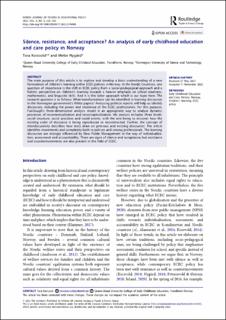| dc.contributor.author | Korsvold, Tora | |
| dc.contributor.author | Nygård, Mette | |
| dc.coverage.spatial | Norway | en_US |
| dc.date.accessioned | 2023-03-15T12:41:06Z | |
| dc.date.available | 2023-03-15T12:41:06Z | |
| dc.date.created | 2022-11-28T09:32:46Z | |
| dc.date.issued | 2022 | |
| dc.identifier.citation | Nordic Journal of Studies in Educational Policy. 2022, 8 (3), 225-234. | en_US |
| dc.identifier.issn | 2002-0317 | |
| dc.identifier.uri | https://hdl.handle.net/11250/3058424 | |
| dc.description.abstract | The main purpose of this article is to explore and develop a basic understanding of a new formulation of children’s learning within ECEC policies in Norway. In the Nordic Countries, one question of importance is the shift in ECEC policy from a social-pedagogical approach and a holistic perspective on children’s learning towards a heavier emphasis on school readiness, mathematics, and linguistic skills. And it is this latter approach which is our topic here. The research question is as follows: What transformations can be identified in learning discourses in the Norwegian government’s White papers? Analysing political reports will help us identify discourses, including the power and resistance of the ECEC professionals. For this purpose, Fairclough’s three-dimensional analysis model is an appropriate way to analyse dynamic processes of recontextualization and reconceptualization. His analysis includes three levels: social structure, social practices and social events, with the aim being to discover how the existing order of discourse is being reproduced or reconstructed. Further, the concept of interdiscursivity describes how texts draw on previous and existing discourses. The article identifies movements and complexity both in policies and among professionals. The learning discourses are strongly influenced by New Public Management in the way of individualization, assessment and accountability. There are signs of silence and acceptance, but resistance and countermovements are also present in the field of ECEC. | en_US |
| dc.description.abstract | Silence, resistance, and acceptance? An analysis of early childhood education and care policy in Norway | en_US |
| dc.language.iso | eng | en_US |
| dc.publisher | Taylor & Francis | en_US |
| dc.rights | Navngivelse-Ikkekommersiell 4.0 Internasjonal | * |
| dc.rights | Navngivelse-Ikkekommersiell 4.0 Internasjonal | * |
| dc.rights.uri | http://creativecommons.org/licenses/by-nc/4.0/deed.no | * |
| dc.subject | Barndomsstudier | en_US |
| dc.subject | Childhood studies | en_US |
| dc.subject | History; | en_US |
| dc.subject | ECEC policy; | en_US |
| dc.title | Silence, resistance, and acceptance? An analysis of early childhood education and care policy in Norway | en_US |
| dc.type | Peer reviewed | en_US |
| dc.type | Journal article | en_US |
| dc.description.version | publishedVersion | en_US |
| dc.rights.holder | ©2022 Authors | en_US |
| dc.subject.nsi | VDP::Pedagogiske fag: 280 | en_US |
| dc.subject.nsi | VDP::Education: 280 | en_US |
| dc.source.pagenumber | 225-234 | en_US |
| dc.source.volume | 8 | en_US |
| dc.source.journal | Nordic Journal of Studies in Educational Policy | en_US |
| dc.source.issue | 3 | en_US |
| dc.identifier.doi | 10.1080/20020317.2022.2148406 | |
| dc.identifier.cristin | 2082090 | |
| cristin.ispublished | true | |
| cristin.fulltext | original | |
| cristin.fulltext | original | |
| cristin.qualitycode | 1 | |

